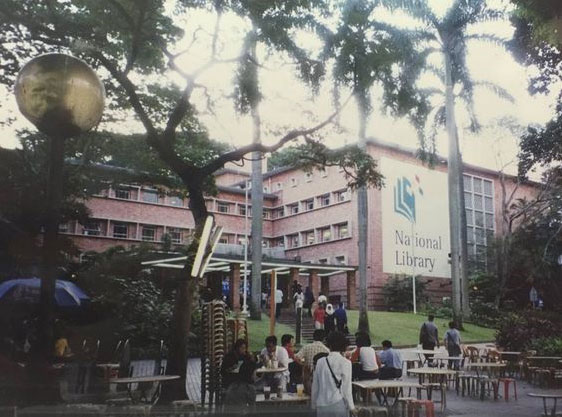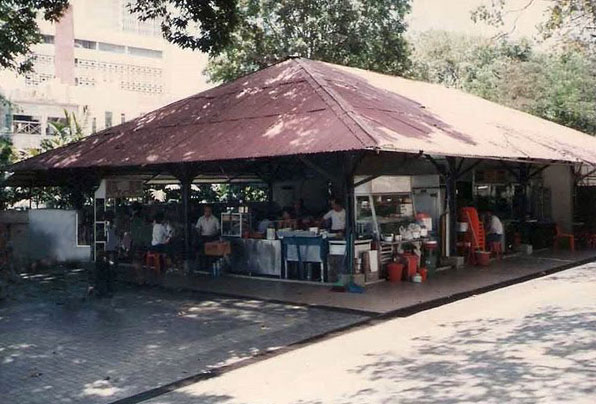Was the demolishing of the old National Library a well-thought decision?
thought decision?

The Old National Library Building was closed on 31 March 2004, and was demolished in 2005 to make way for the construction of the Fort Canning Tunnel (FCT) to ease road traffic to the city.
The FCT project was based on the Urban Redevelopment Authority (URA)’s plans for the Museum Planning Area.
It is said that in the proposal by URA that over 3,000 vehicles pass through Stamford Road every hour during peak periods and with the old traffic scheme, motorists stopped at 2 traffic lights at slow speeds, which made the area prone to congestion. In view of increased traffic from new developments in Marina Centre and Marina South to the Orchard shopping area design plans for the tunnel were drawn up to allow motorists to bypass several traffic junctions.
URA noted that by cutting through Fort Canning Hill, the historical and environmental significance of the area would still be preserved. The tunnel was said to cut journey times from 5 minutes to as fast as 18 seconds.
An unfortunate turn of event for many who cherished the national icon of Singapore which had survived through the turbulent times of World War 2, but could not defend itself in the name of saving 5 minutes from the peak hour commute.
Public Dissent on the demolishing of the old National Library as quoted from Wikipedia
Below is Mr Lui’s reply to Mr Baey
thought decision?

The Old National Library Building was closed on 31 March 2004, and was demolished in 2005 to make way for the construction of the Fort Canning Tunnel (FCT) to ease road traffic to the city.
The FCT project was based on the Urban Redevelopment Authority (URA)’s plans for the Museum Planning Area.
It is said that in the proposal by URA that over 3,000 vehicles pass through Stamford Road every hour during peak periods and with the old traffic scheme, motorists stopped at 2 traffic lights at slow speeds, which made the area prone to congestion. In view of increased traffic from new developments in Marina Centre and Marina South to the Orchard shopping area design plans for the tunnel were drawn up to allow motorists to bypass several traffic junctions.
URA noted that by cutting through Fort Canning Hill, the historical and environmental significance of the area would still be preserved. The tunnel was said to cut journey times from 5 minutes to as fast as 18 seconds.
An unfortunate turn of event for many who cherished the national icon of Singapore which had survived through the turbulent times of World War 2, but could not defend itself in the name of saving 5 minutes from the peak hour commute.
Public Dissent on the demolishing of the old National Library as quoted from Wikipedia
Soon after the completion of the FCT, Former Nominated Member of Parliament, Siew Kum Hong wrote a piece to the papers, entitled, “Was the Fort Canning Tunnel worth it, after all?”.From March to April 1999, there arose a huge groundswell of public dissent in the media over the National Library building’s fate, as well as the drastic physical alterations of its environs. A number of featured columns by journalists touched on gradually disappearing heritage landmarks, as well as shared memories of Singaporeans.
On 24 January 2000, after SMU chaired a technical workshop to obtain feedback on three alternative proposals, a well-known architect named Tay Kheng Soon held a press conference at The Substation to unveil his unofficial SMU masterplan. URA was invited to the presentation but did not show up. His proposal entailed re-routing the tunnel in order to save the National Library building. A week later, Tay wrote to the Prime Minister’s Office regarding his proposal which was referred to the MND. Many members of the public wrote in publicly either in support of Tay’s plans or argue for heritage conservation in general. A few articles and letters highlighted that the adamant official response to public dissent ran counter to the spirit of the Government’s S21 Vision, which expressed a desire to foster civic participation and active citizenry.
In May 2013, MP for Tampines GRC, Baey Yam Keng asked Minister for Transport, Lui Tuck Yew in parliament on how the FCT has brought improvement to traffic conditions and how has the experience helped to fine-tune the current system of assessing the benefits of public transport infrastructure development against the costs of the destruction of tangible and intangible assets such as heritage landmarks and national icons.“…But how important is five minutes to Singaporean motorists, especially when, given the route involved, it is likely to be leisure time? After all, many motorists are willing to spend more than five minutes to take a more circuitous route, to avoid paying ERP.
Furthermore, this time saved needs to be balanced against the increased time spent by motorists turning towards Serangoon Road, who now have to navigate an additional turn and a new pedestrian crossing. I’ve also noticed that buses leaving the Capitol Building bus stop now have to edge their way across two lanes to turn right before the tunnel, frequently slowing traffic along Stamford Road.
So even as motorists heading into Penang Road save time, those turning towards Serangoon Road spend more time.
The other benefit cited was the freeing up of a football field-sized plot of land, now made available for use by the Singapore Management University. This is prime land, and is certainly valuable.
On the other hand, the land surrounding and above the tunnel is now unavailable for development. Furthermore, there is the $34 million spent to build the tunnel, and the ongoing maintenance costs of the tunnel.
The value of the land freed up must be offset against these factors. When the costs resulting from the tunnel are identified and totalled up, the benefits look even less impressive than they originally did.
And let’s not forget the intangible and unquantifiable cost, namely the destruction of a landmark building cherished by so many Singaporeans.
…And despite the official stance that the National Library building had no special historical or architectural value and was not worthy of conservation, it certainly was a place that many Singaporeans remembered and were fond of, and I daresay much more so than many other officially sanctioned heritage buildings.
That being the case, and in view of Mr Yap’s comments, the public especially those Singaporeans who had argued so passionately against the project deserves a full and clear explanation from the LTA as to why it decided to demolish the National Library to build the tunnel, and the cost-benefit analysis undertaken by it.
Below is Mr Lui’s reply to Mr Baey
In an interview with Channel News Asia published in February 2015, URA’s Chief Planner Lim Eng Hwee answered the question of whether were there any “planning mistakes” and what has been done to rectify them.Mr Lui Tuck Yew: Let me start with a brief background on the Fort Canning Tunnel. The tunnel was first mooted when URA formulated the Civic District Master Plan for the Bras Basah area, back in 1988.
There was active public engagement on the plans back then, particularly on the issue of retaining the National Library building. Options to improve the transportation network in the area were carefully studied. The conclusion was that a realignment of Stamford Road and a tunnel through Fort Canning Hill was the best option to realise the Master Plan’s objective of creating a vibrant and pedestrian-friendly civic district around the Bras Basah area. The tunnel would provide the most direct link for traffic from Marina Centre and the Central Business District to Orchard Road, and in turn siphon traffic away from the Bras Basah area, making it more pleasant for pedestrians.
Therefore, the Fort Canning Tunnel was not justified by traffic benefits alone, but to realize other benefits for the public and in optimising land use for the area. When constructing the tunnel, the Land Transport Authority (LTA) chose the method of tunneling that would cause the least disturbance to the surroundings and saved about 35 trees, including an iconic 50-year old Terap tree.
Since its opening in January 2007, the Fort Canning Tunnel has served its objectives. Traffic has been diverted from Stamford Road, and public buses can now ply smoothly with minimal delays at junctions. With the narrowing of Stamford Road from four to three lanes, pedestrians too have a better walking experience in the area.
It is difficult, if not impossible, to attach a dollar value to heritage landmarks and national icons when evaluating the costs and benefits of a project. We are mindful to adopt a balanced approach by taking into consideration both the tangible and intangible aspects of projects. Decisions are not made on monetary costs and benefits alone. The preservation of heritage landmarks and national icons has always been an important consideration in our planning process, and will continue to be so going forward.
I am not sure if this is a mistake. Often you make certain decisions in the context of the situation at that point in time. One particular area is perhaps in the area of conservation. For obvious reasons, in the 60s and 70s, we were faced with huge challenges – unemployment, the acute housing shortage, and the city centre was so crowded.
The focus was not on whether heritage buildings should be conserved. So you see a lot of massive, comprehensive redevelopment, where so many old buildings were removed. Looking back in hindsight of course, we say some of these unique buildings ought to be kept.
Starting from the 80s, the planners and the decision makers at that point in time started to think about whether we should start to retain these heritage buildings which are important anchors for future generations. The buildings will provide a link for them to identify with their past. So the conservation journey really started in the 80s.
Having kept these buildings is not enough. Having retained them, I think we should now think about how can we help people to understand more of the history behind these buildings. We have to encourage people to start talking about the buildings, and share their personal stories so that the younger generation, when they look at the building, they understand the history behind them. I would not think that the decision made then to demolish the buildings as mistakes – it is really contextual.









